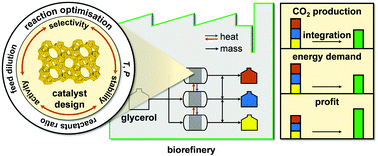当前位置:
X-MOL 学术
›
Energy Environ. Sci.
›
论文详情
Our official English website, www.x-mol.net, welcomes your feedback! (Note: you will need to create a separate account there.)
Environmental and economical perspectives of a glycerol biorefinery†
Energy & Environmental Science ( IF 32.5 ) Pub Date : 2018-02-26 00:00:00 , DOI: 10.1039/c7ee03116e Giacomo M. Lari 1, 2, 3, 4, 5 , Giorgio Pastore 1, 2, 3, 4, 5 , Moritz Haus 1, 2, 3, 4, 5 , Yiyu Ding 6, 7, 8, 9, 10 , Stavros Papadokonstantakis 6, 7, 8, 9, 10 , Cecilia Mondelli 1, 2, 3, 4, 5 , Javier Pérez-Ramírez 1, 2, 3, 4, 5
Energy & Environmental Science ( IF 32.5 ) Pub Date : 2018-02-26 00:00:00 , DOI: 10.1039/c7ee03116e Giacomo M. Lari 1, 2, 3, 4, 5 , Giorgio Pastore 1, 2, 3, 4, 5 , Moritz Haus 1, 2, 3, 4, 5 , Yiyu Ding 6, 7, 8, 9, 10 , Stavros Papadokonstantakis 6, 7, 8, 9, 10 , Cecilia Mondelli 1, 2, 3, 4, 5 , Javier Pérez-Ramírez 1, 2, 3, 4, 5
Affiliation

|
Glycerol conversion into chemicals and fuel additives is pursued to valorise a burgeoning by-product in the bioenergy sector. To this aim, heterogeneous catalysts have been developed that enable, in many cases, efficient and green transformations. Still, the evaluation of the environmental and economic footprint that would be associated with their large-scale application has often been neglected, limiting their commercial attractiveness. Furthermore, the impact of integrating different glycerol upgrading routes within a biorefinery, which is highly instrumental to determine the effective sustainability and profitability of biodiesel production from vegetable oils, has not been assessed. Here, the manufacture of the most relevant chemical derivatives of glycerol is considered, i.e., lactic acid, acrylic acid, glycerol carbonate, propanediols, epichlorohydrin and allyl alcohol. State-of-the-art catalysts for each upgrading route are briefly reviewed. Based on their performances, processes are rigorously modelled and relevant indicators, the global warming potential, the cumulative energy demand and the operating costs, quantified by life-cycle analysis. Glycerol-based processes are generally found more attractive than the conventional technologies nowadays applied for the production of the same chemicals, among which the paths to lactic acid and glycerol carbonate are particularly promising. In addition, the process variables mostly contributing to the environmental and cost metrics are identified. Accordingly, future studies should target further optimisation mainly in relation to selectivity, solvent volatility, reactants ratio and catalyst stability. Finally, the processes are integrated simulating a prospective glycerol biorefinery and the advantages deriving from the exchange of heat between the different routes quantified. If the glycerol feed is split equally among all routes the CO2 emissions and energy requirements are decreased by 15 and 32%, respectively, and the profit is increased by 5% as compared to the sum of the individual glycerol-based processes. In order to minimise the ecological impact of the biorefinery, glycerol should be rather divided in an 80 : 20 mass ratio among 1,2-propanediol and glycerol carbonate production, which are expected to have a significant market size. The innovative approach outlined in this work holds potential to guide both fundamental chemical research and process design in the development of CO2 and other bio-refineries.
中文翻译:

甘油生物精炼厂的环境和经济观点†
追求将甘油转化为化学物质和燃料添加剂的目的是使生物能源领域新兴的副产品增值。为此目的,已经开发了能够在许多情况下实现高效和绿色转化的非均相催化剂。尽管如此,人们常常忽略了与大规模应用有关的环境和经济足迹评估,从而限制了它们的商业吸引力。此外,尚未评估在生物精炼厂中整合不同甘油升级路线的影响,这对于确定植物油生产生物柴油的有效可持续性和盈利能力至关重要。在此,考虑了最相关的甘油化学衍生物的生产,即,乳酸,丙烯酸,碳酸甘油酯,丙二醇,环氧氯丙烷和烯丙醇。简要回顾了每种升级途径的最新催化剂。根据其性能,对流程进行严格建模,并通过生命周期分析对相关指标,全球变暖潜力,累积能源需求和运营成本进行量化。通常发现基于甘油的方法比当今用于生产相同化学品的常规技术更具吸引力,其中,向乳酸和碳酸甘油酯的途径特别有前途。此外,还确定了主要有助于环境和成本指标的过程变量。因此,未来的研究应主要针对选择性,溶剂挥发性,反应物比例和催化剂稳定性。最后,将这些过程进行集成以模拟预期的甘油生物精炼厂,并量化不同路线之间的热交换所带来的优势。如果甘油进料在所有路线中平均分配,则CO与基于甘油的单个工艺的总和相比, 2排放量和能量需求分别减少了15%和32%,利润增加了5%。为了最大程度地降低生物精炼厂的生态影响,应将甘油按80:20的质量比分配给1,2-丙二醇和碳酸甘油酯生产,它们的市场规模预计很大。这项工作中概述的创新方法具有潜力,可指导基础化学研究和工艺设计,以开发CO 2和其他生物精炼厂。
更新日期:2018-02-26
中文翻译:

甘油生物精炼厂的环境和经济观点†
追求将甘油转化为化学物质和燃料添加剂的目的是使生物能源领域新兴的副产品增值。为此目的,已经开发了能够在许多情况下实现高效和绿色转化的非均相催化剂。尽管如此,人们常常忽略了与大规模应用有关的环境和经济足迹评估,从而限制了它们的商业吸引力。此外,尚未评估在生物精炼厂中整合不同甘油升级路线的影响,这对于确定植物油生产生物柴油的有效可持续性和盈利能力至关重要。在此,考虑了最相关的甘油化学衍生物的生产,即,乳酸,丙烯酸,碳酸甘油酯,丙二醇,环氧氯丙烷和烯丙醇。简要回顾了每种升级途径的最新催化剂。根据其性能,对流程进行严格建模,并通过生命周期分析对相关指标,全球变暖潜力,累积能源需求和运营成本进行量化。通常发现基于甘油的方法比当今用于生产相同化学品的常规技术更具吸引力,其中,向乳酸和碳酸甘油酯的途径特别有前途。此外,还确定了主要有助于环境和成本指标的过程变量。因此,未来的研究应主要针对选择性,溶剂挥发性,反应物比例和催化剂稳定性。最后,将这些过程进行集成以模拟预期的甘油生物精炼厂,并量化不同路线之间的热交换所带来的优势。如果甘油进料在所有路线中平均分配,则CO与基于甘油的单个工艺的总和相比, 2排放量和能量需求分别减少了15%和32%,利润增加了5%。为了最大程度地降低生物精炼厂的生态影响,应将甘油按80:20的质量比分配给1,2-丙二醇和碳酸甘油酯生产,它们的市场规模预计很大。这项工作中概述的创新方法具有潜力,可指导基础化学研究和工艺设计,以开发CO 2和其他生物精炼厂。



























 京公网安备 11010802027423号
京公网安备 11010802027423号